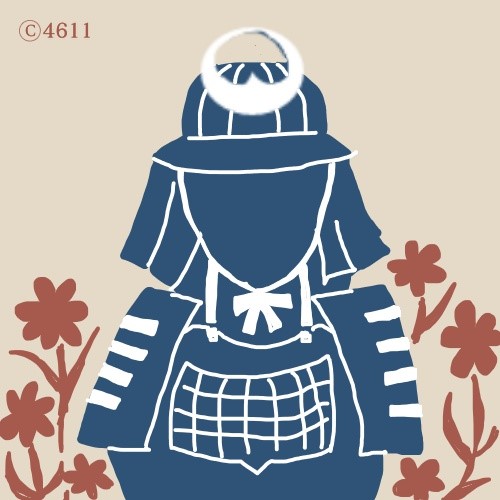本ブログは観光業、企業接待、留学生対応等で英語案内が必要ながら、多忙で準備に時間をかけられない方々の為にすぐに使える情報を分かりやすく解説しています。今回はビジネスで来日中の重要顧客を商談後、江戸時代往時の面影を今に伝える武家屋敷跡の『野村家』へ、急遽ご案内することになった際の英語表現をご紹介します。
👉本ブログでは目の前の物を一緒に見ているインバウンドに、できるだけ思考を求めない、また一般的には関心が薄いと言われる固有名詞(名前、地名等)や年代は極力控えた、よりわかり易い口頭説明を目指していますので、高度で詳細情報をご希望の場合は公式or専門サイトをご利用下さい。公式サイトは最後にご紹介していますので目次よりご参照ください。👉直接インバウンドに向けてまとめた英語版ご参照の際はこちらからどうぞ!
0.事前の心得として
0.1 基本用語:諸々の説明の為に
メインに入る前に、本ブログタイトルにもありました簡単な基本用語をご紹介します。
- 野村家 / The Nomura Family Samurai House
- 古くからの武家屋敷街/old samurai town atmosphere/traditional samurai residence district
- 👉野村家のある長町界隈は色々な単語の組み合わせて表現できますので、お好みでチョイスですね。
- 武家屋敷跡 / a restored samurai residence
- 👉野村家は移築復元されたので。
- 伝来の刀剣と甲冑/ancestral swords and armors
0.2 業務用語:支障のない進行の為に
👉野村家対応に限りませんが、想定外の人数を案内する場合、事前にお伝えしておきたい説明例です。
- 人気スポットなので混雑が予想されること。(特に週末や天候が悪いとき)
- 通常の日本の家なので玄関は狭く一度に大勢入れない。
- 混んでいても割り込まないで野村家の前の駐車場から列に並んで順番に入館してほしい。
- 野村家の隣のお菓子屋の前にいると邪魔なので立ち止まらないでほしい。
- 混雑のピークを避けたい場合は、野村家の側の2件の店で軽食や休憩しながら様子を見ることも可能。
- 但し、どの時間帯に混雑が緩和するかはわからない。
- 入館料にカードが使えないので現金を用意しておいてほしい。
- 入館手続きが終わったら、靴を脱いで目の前の棚に入れてほしい。
- 館内は案内版に従って、ご自分のペースで進んでほしい。
- 時間制限はないので好きなだけいてもよい。
- 中にトイレはあるが、数は多くないので、事前に済ましておいてほしい。
- 全館禁煙なので近くの喫煙所でお願いしたい。
👉前半No1~6と後半6~12は音声サンプル話者が変わります。同じ米国女性でも喋り方で印象が違う点もお楽しみ下さい。
- As this is a popular spot, it is expected to be crowded (especially on weekends or during bad weather).
- Since it is a typical Japanese house, the entrance is narrow and cannot accommodate many people at once.
- Please do not cut in line, even if it is crowded, and line up in order from the parking lot in front of the house.
- Please do not stop in front of the adjacent sweet shop as you are in the way.
- If you want to avoid peak hours, you can observe the situation from the nearby shops where you can grab a snack or take a break.
- However, it is not known at what time the crowds will ease.
- Please prepare cash as you cannot use credit cards for admission fees.
- After completing the admission procedure, please take off your shoes and put them on the shelf in front of you.
- Please follow the guide board inside the house and proceed at your own pace.
- There is no time limit, so feel free to stay as long as you like.
- There is a restroom inside, but there are not many, so please go to a lavatory in advance.
- Smoking is prohibited throughout the building, so please use the nearby designated smoking area.
1. 基本情報
まずは、中に入る前の基本的なご説明例を段階的にご紹介します。いつも通り、日本語で説明できないことは英語でも説明できませんので、日本語→英語の順番です。
👉インバウンドでの知名度は高く、彼らもネットでそれなりの情報と画像は見ているかもしれませんが、旅行中は細かいことは覚えてませんし、何よりも地元の日本人の話しにも興味があるので、本番のご案内をスムーズに進める為にも、何とかここは上手くお伝えしたいですね。
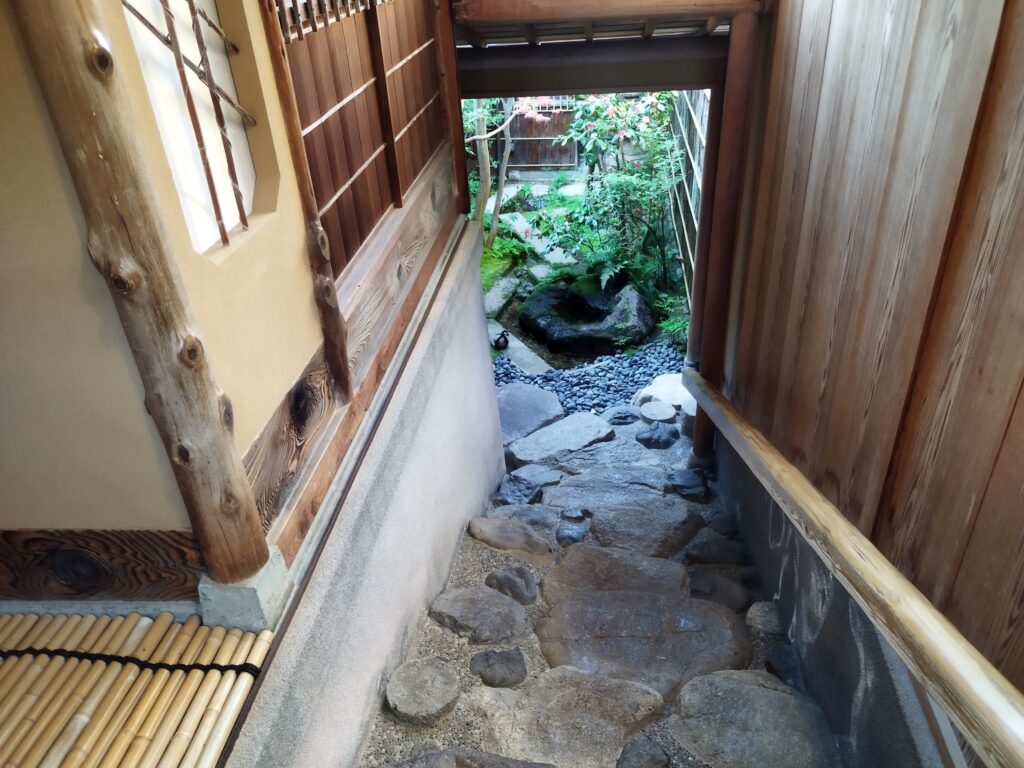
1.1 かいつまんで言うなら(標準的インバウンド向け)
👉かなり要約しておりますが、相手によってはこれでも長く難しいかもしれません。
- 1800年代(約200年前)に建てられた野村家の屋敷を復元したもの。
- 野村家は加賀藩主代々の上級家臣。企業で言えば執行役員クラス。
- 上級武家の当時の屋敷の雰囲気が、庭園、茶室、道具で鑑賞できる。
- 特にお勧めは庭園と茶室で、ただ座っているだけで侍の気分になれる。
👉その英訳例です。
- This house is a restored residence of the Nomura family, which was built in the 1800s (about 200 years ago).
- The Nomura family were senior retainers who served their lord for generations, equivalent to senior executive officers in modern corporations.
- Here, you can appreciate the atmosphere of a senior samurai’s residence at that time by viewing the garden, tea room, and utensils.
- The garden and tea room are especially recommended, as anyone can feel like a samurai just by sitting there.

1.2 もっと簡略化するなら(英語が第二言語の方向け)
👉もう少し簡略化してみました。英語が母国語でない人や日本知識のない方向けにどうでしょうか。
- この武家屋敷街で唯一公開されている貴重な場所。
- ここの住民は上級クラスの侍であった。
- 庭園と茶室に入れば、当時の武士の日常生活が伺える。
👉その英訳例です。
- This house is a valuable place, as it is the only one open to the public in this samurai mansion district.
- The residents here were upper-class samurai.
- If you enter the garden and tea room, you can get a glimpse of the daily life of the samurai from that time.
1.3 一言で済ませるなら(米国人向け2例)
👉もし一言で済ますとしたらこんな感じでしょうか。特にアメリカ人は同じ意味の単語でも短い方を好んで使うので米国人向き?よりしっくりくる方をお試しください。
- 最近まで武士が住んでいたような感じにさせられる異次元空間だ。
- 京都の禅寺の修行の庭と違って、侍の生活の庭が体験できる。
- 👉「京都」は相手次第で冗長かもしれませんね。
- The house feels like an another dimension that until recently had been inhabited by a samurai.
- Unlike the meditation gardens of Kyoto’s Zen temples, you can experience a garden that reflects the daily life of a samurai.
2.インバウンドの視点!笑いが取れるかも?
ここからは実際に野村家の中を見ながら、各所を眼の前にして自然に湧き上がるインバウンドの疑問や好奇心を想定した説明例です。👉真面目&笑いネタと日常会話表現を織り込んでますので英語の雑談力アップになるかも!
2.1 玄関・入口
玄関を入るとすぐ甲冑が目に入りますが、これは野村伝兵衛が実際に着用したものです。混んでいる狭い玄関前なので、長い説明は不適ですが、説明ボードについても聞かれる可能性もありますので、それも踏まえた想定問答例です。
Q1.甲冑:この甲冑は何なんですか?
“What is this armor?”
Q1では昆虫用語を多く織り込みました。前半(No1-6)は説明にも使える真面目パート、後半(No7-10)は雑談力アップ用のおふざけパートです。👉末尾の英語音声話者は鎧のような手堅いトーンの英国男性です。👄本パート表現の習得用演習ツールご利用はこちらへ!
- 野村家初代当主が実際に身に着けた甲冑です。
- これを着た戦で手柄を立て上級武士に取り立てられました。
- このボードには、その戦の詳細が書かれています。
- 金沢城の領主まだ不安定な時期でした。
- 野村家当主は槍で戦ったそうです。
- 博物館でよく見る装飾的な甲冑と違って、兜もコンパクトで実戦的です。
- 日本では、鎧の兜の部分を「カブト」(かぶと虫の意味合い)と呼び、前立ての飾りを「クワガタ」(くわがた虫の意味合い)と呼びます。
- 一般に「クワガタ」の装飾と大きさが武士の身分を示しますが、通常一対の角を持つクワガタムシと違い、この「クワガタ」は先が閉じています。
- 当主は当時、下級武士だったため、カブトムシの角の様に槍で道を切り開くしか生きる道はないと思ったのかもしれません
- この兜のクワガタ飾りの閉じた円は、当時の彼のジレンマを象徴しているように見えるかも!

- This is the actual armor worn by the first head of the Nomura family.
- He earned recognition for his valor in battles while wearing this armor, which led to his promotion as a senior samurai.
- This board provides insights into the details of the battles he participated in.
- The lord of Kanazawa Castle was in a period of significant instability at that time.
- The head of the Nomura family was said to have fought with a spear, his specialty.
- Unlike the ornate armor often displayed in museums, this helmet is both compact and practical.
- In Japan, the helmet part of the armor is called ‘kabuto’, meaning ‘a beetle’, and its frontal ornament is called ‘kuwagata ‘meaning ‘a stag beetle’.
- Generally, this ornamentation and size of ‘kuwagata’ indicate the status of the samurai, but unlike stag beetles that usually have a pair of horns, this one is closed at the end.
- As he was a low-ranked samurai at the time, he likely felt he had no other way to survive but to make his way with his spear, equivalent to a beetle’s horn.
- The closed circle of the stag beetle ornament on his helmet might symbolize the dilemma he faced at that time!
Q2. 甲冑:彼(初代当主)は本当にこの鎧と同じ位小柄だったの?
“Was he really as small as this armor suggests?“
Q2は実際によく聞かれる質問をベースに鎧と戦に関する表現を織り込んでみました。前半(No1-6)は説明にも使える真面目パート、後半(No7-10)は雑談力アップ用のおふざけパートです。

《日本語》
- 侍の鎧は、外見と機能の両面において、主に2つのタイプに分けられます。
- 一つは、戦場で士気を高める意図を持つ、軍団の将軍や大部隊の指揮官の豪華で人目を引く鎧です。
- もう一つは、歩兵のような最前線の兵士のための機能的な鎧で、戦場での俊敏性や動きやすさを優先しています。
- そのため、この種の鎧は装飾を最小限に抑え、軽量でシンプルな作りになっています。
- 多くの研究によると、侍の時代の日本人男性の平均身長は約5フィート1インチから5フィート3インチ,約155〜160cmだったとされています。
- 鎧は基本的に個人の体格に合わせて作られていたため、展示されている鎧が現代の私たちから見て小さく感じるのは自然なことです。
- 古い日本のことわざに、虎は死して皮を残し、人は死して名を残す、というものがあります。
- このご先祖様は、たとえ体格が小さく、外見は目立たない人物であったとしても、虎が死して皮を残すように、見事に名だけでなく、この鎧も後世に残したのです。
- そして今日でも、彼の魂はこの鎧に宿り、家を守っているようです。
- まさに、英語の “in armor”(鎧をまとっている)という言葉が示すように、彼は自らの遺産を守るために、文字通り鎧をまとっているのです。
《英語》
- Samurai armor comes in two main types, each with a distinct purpose in both appearance and function.
- One is the luxuriously conspicuous armor of a general or a high-ranking commander, intended to boost morale on the battlefield.
- The other is functional armor for front-line soldiers, like infantrymen, which prioritizes agility and ease of movement.
- This armor is made to be lightweight and simple, with minimal decoration.
- According to many studies, the average height of a Japanese man during the samurai period was about 5’1″ to 5’3″ (155 to 160 cm).
- Armor was custom-made to fit the individual’s physique, so it’s natural that the armor on display would seem small to a modern viewer.
- Japanese proverbs say that just as a tiger leaves its skin behind when it dies, a person should leave behind a good name.
- Although this ancestor might have been small in stature and unremarkable in appearance, he not only successfully left behind his name but also his armor, just as a tiger leaves its skin.
- Even today, his spirit seems to reside in his armor, protecting his family.
- As the English saying goes, he is literally in armor—ready to defend his legacy.
2.2 鬼川文庫
👉👉ここだけは、インバウンドの嗜好の個人差が大きく、全く面白くなかった、と評価されない書き込みも多いですが、こちらの案内次第で相手の印象が大きく変わるところです。さりとてマニア向けの専門用語は難しいので、いかにシンプルに腑に落ちる説明ができるか腕の見せ所かもしれません。
Q1. 背景(Background):何故ここに展示室があるのですか?
“Why is there an exhibition room here?”
Q1では博物館用語を多めに置きました。前半(No1-6)は説明にも使える真面目パート、後半(No7-10)は雑談力アップ用のおふざけパートです。👉英語音声は教師の講義調の英国女性話者です。👄本パート表現の習得用演習ツールご利用はこちらへ!
《日本語》
- 武家屋敷地区の高級武士達は領主、貴族、豪商との人脈がありました。
- 彼らは珍しく高価なコレクションを保持していました。
- サムライ時代の終焉により、彼らは経済的に困窮し、土地、家財を処分しなければならなりませんでした。
- 貴重な武士のお宝も多くが散逸しました。
- その中でも、野村家では先祖伝来の刀剣、書状が保持されていました。
- 著名な博物館でしか見られないサムライ時代の工芸品がここで楽しめます。
- なんといっても、大量の広告費スタッフ付きの博物館よりも遥かに低コストです。
- この野村家の末裔は見事に苦難を乗り越え、この家を大きな公的な美術館に委ねることはしませんでした。
- さらに、我々、現地ガイドは、高コスト博物館に比べて、ほんのわずかな費用で、興味をそそる説得力のある説明をご提供できます。
- なぜなら、仕えるしか道がなかった当時の下級武士たちと同じ気分かもしれないので。
《英訳例》
- In the samurai residence area, high-ranking samurai maintained close ties with lords, aristocrats, and wealthy merchants.
- They amassed impressive collections of rare and valuable items.
- When the samurai era came to an end, many of them faced financial difficulties and were forced to sell their land and family possessions.
- As a result, numerous precious samurai treasures were dispersed.
- The Nomura family, however, managed to preserve ancestral swords and letters.
- Visitors here have a unique opportunity to admire these samurai-era artifacts, typically found only in renowned museums.
- The best part? It’s more affordable than visiting those heavily advertised and staffed museums.
- A descendant of the Nomura family successfully preserved their ancestral home, overcoming various challenges and choosing not to turn it into a large public museum.
- Moreover, as local guides, we can offer captivating and compelling explanations at a fraction of the cost of expensive museums!
- Perhaps this is because we share a similar mindset and position as the lower-class samurais of that time, who had no choice but to serve.
Q2.書簡(letters):この感謝状のどこに価値があるの?
“What is valuable in this letter of gratitude?”
見れば手紙とわかるので、その手紙の価値を(インバウンドの高い興味対象の)日本人の性格特徴としてお伝えするのがおススメです。基本通り、相手がマニアでなければ、固有名詞(明智光秀、朝倉敏景)や年代は極力避けます。ここも、いずれかのセリフで、日本人の不思議さが上手くお伝えできれば良いですね。
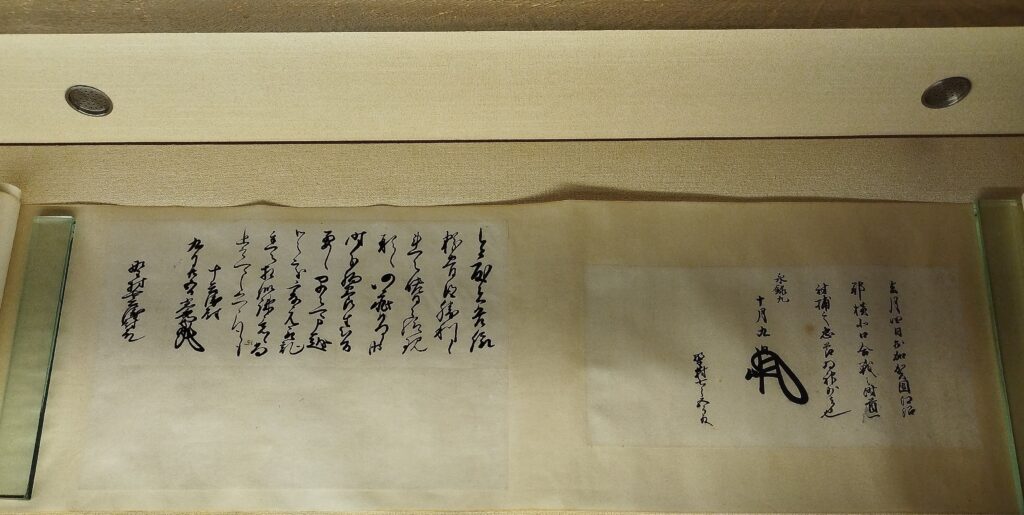
by GOLD♦ 実物をぜひ観に来てくださいね!♦Please come see the real thing!
まずは明智光秀の感謝状で纏めてみました。前半(No1-4)は説明にも使える真面目パート、後半(No5-10)は雑談力アップ用のおふざけパートです。ここでは「裏切り」に関する用語を多めに置きました。👉英語音声は、キングの死を悼む調子の米国女性話者。👄本パート表現の習得用演習ツールご利用はこちらへ!
《日本語》
- これは日本史上、最大の裏切り者として有名なサムライからの感謝状です。
- 世界史では「ユダ」や「ブルータス」がその代表例として有名ですが、彼も日本史で同様に位置付けられています。
- 彼は当時事実上の日本のキングであった自分のボスが休養中、自分の軍隊を差し向けて殺したのです。
- 彼はそのキングに、それまでとても従順で忠実だったので、その裏切り行為は今でもミステリーとされてます。
- 野村家が仕えていた金沢城の領主も、城主になる前の当時は、その殺されたキングの部下で、その裏切り者の同僚でした。
- もし、そのキングが殺されていなかったら、金沢城の領主もその部下の野村家もなかったでしょう。
- 何故なら、そのキングはかなりの暴君で、成果を出しているうちは良いけれど、ダメだしされた多くの部下たちは左遷されたか、最悪の場合は切腹を命じられたりもしました。
- 専門家によると彼の多くの部下たちがそのキングに従っていたのは恐怖心からだったと言われています。
- その裏切り者も、その後の金沢城の城主も遅かれ早かれ殺されていたかもしれません。
- 感謝状を出したかったのは、その裏切り者でなく、むしろ、野村家の方だったかもしれませんね。
《英訳例》
- This is a letter of gratitude from a samurai known for one of the most notable betrayals in Japanese history.
- Just as “Judas” and “Brutus” are well-known examples in world history, he holds a similar position in Japanese history.
- He sent his own troops to kill his boss, who was then the de facto king of Japan, while the latter was resting
- He had been so obedient and loyal to that king up to that point that his betrayal is still considered a mystery.
- At the time of the betrayal, before the lord of Kanazawa Castle assumed his position, he was subordinate to the murdered king and a colleague of the traitor.
- If the king had not met his unfortunate end, there might not have been a Lord of Kanazawa Castle and its retainers, including the Nomura family.
- The king’s tyrannical nature led to the punishment or forced removal of many of his subordinates who failed to meet his expectations, with the most severe consequence being ordered to commit seppuku (ritual suicide).
- Experts suggest that fear, rather than respect or rationality, compelled many of his men to follow him.
- Both the traitor and the subsequent lord of Kanazawa Castle might have faced their demise sooner or later.
- It’s possible that it was the Nomura family, not the traitor that wanted to write a ‘thank you’ letter for the betrayal.
Q3. 刀剣(Swords):この刀剣は実際に使われたものですか?
”Were these swords actually used?”
技術好みのインバウンドには刀剣ファンが多いので、逆に多くの質問は不要でしょう。見ているだけでその機能美がわかりますので。それでも、よく聞かれる質問からここでも日本人の特徴(価値観)について、ちょっと触れています。刀剣用語を多くしました。前半(No1-5)は説明にも使える真面目パート、後半(No6-10)は雑談力アップ用のおふざけパートです。👉英語音声は、武士の魂を語るにふさわしい落ち着いた感じの米国女性話者です。👄本パート表現の習得用演習ツールご利用はこちらへ!

《日本語》
- サムライ時代の後期は比較的平和な時代だったので、刀剣の多くは観賞用となってました。
- 2~3百年以上の刀とは思えない機能と美を兼ね備えています。
- 武士が没落する中でも手放さなかったのは、サムライの最後のプライドだったかもしれません。
- ’刀剣はサムライの魂’が当時の価値観でしたから、どんなに困っても魂は売らなかったのですね。
- ’悪魔に魂を売っても生き残りたい’商人と対極ですね。
- そうなると、武士と商人との主導権を争う勝負は最初から見えていたとも言えます。
- 約千年にわたり、刀剣で生き抜いてきたサムライにとって、この平和の時代の武器はただのプライドの遺産に過ぎません。
- これは、聖書の有名な”剣に生き、剣に死ぬ “を思い起こさせますね。
- 武士は時空を超えてそれを証明したと言えるかもしれませんね。必ずしも文字通りの意味でなく。
- 彼らは単に剣で死んだのではなく、剣にしがみつき売らなかったんです。生きるためにその遺産を売るべきだったかもって時にね。
《英訳例》
- The late Samurai period was marked by relative peace, leading to the creation of many ornamental swords.
- It’s astounding that these swords are more than two or three hundred years old because they retain both functionality and beauty.
- It could be considered the last source of pride for the Samurai that they didn’t sell these swords, even amidst the decline of Samurai families.
- ‘A sword is the soul of a samurai’ held great value. So, no matter how dire their circumstances, it might have been unthinkable to ‘sell their souls’.
- Samurai stood in contrast to merchants who prioritized survival, even if it meant ‘selling their souls to the devil’.
- It could be said, then, that the contest for leadership between the samurai and the merchants was predictable from the beginning.
- For samurai who had survived by the sword for nearly a thousand years, the weapon became a legacy of pride, even in peaceful times.
- This recalls the famous biblical saying, “Live by the sword, die by the sword.”
- One might argue that the samurai proved this true across time and space—not necessarily in the literal sense.
- They didn’t just die by the sword; they clung to it, refusing to sell, even when it might have been wiser to trade their legacy for survival.
Q4. 鐙(あぶみ/stirrup):この陳列品は何に使われていたんですか?
”What was this display used for?”
《銀象嵌牡丹文鐙》の難しい説明は省きますが、馬具に銀線を埋め込んだ装飾を施したものです。インバウンドはそもそも何かわからないので、それだけコメントすれば十分かもしれませんが、圧倒的に多い質問から纏めてみました。

10文の内、前半(No1-5)は説明にも使える真面目パート、後半(No6-10)は雑談力アップ用のおふざけパートです。今回は馬具用語を多めに織り込んでます。👉英語音声は当時、馬とは無縁であった若々しいオーストラリア男性話者に語っていただきます。👄本パート表現の習得用演習ツールご利用はこちらへ!
《日本語》
- これは鞍(くら)の両側に取り付けられた装飾的な足置きです。
- 鐙(あぶみ)は、戦闘中の馬の激しい動きの中で姿勢を維持し、騎手が効果的に敵を攻撃することを可能にしました。
- しかし、この特定の鐙は実用的な目的ではなく、銀線を埋め込んで装飾されています。
- 前述の刀と同様に、鐙も平和な武士の時代に装飾的な特徴を備えるようになりました。
- それは熟練した職人によってデザイン製作され、金沢が多くの才能ある職人を輩出したことを証明しています。
- 銀は一般的に指輪に使用されますが、主に足を入れるための鐙にそのような貴重な金属を使用することは贅沢に思えるかもしれません。
- しかし、武士の時代から金箔工芸で有名な金沢では、金以外の金属はそれほど高く評価されていなかったかもしれません。
- 実際、金沢の人々は「足」の場所に金を埋め込むことは決して考えません。
- 金沢の人々にとって、金は非常に重要であり、より重要な用途に充てられています。
- これがおそらく、今日多くの人が金箔アイスクリームで味覚と視覚を同時に楽しんでいる理由でしょうね!
《英訳例》
- This is a decorative footrest that was placed on both sides of the saddle.
- Stirrups were essential for maintaining posture during the violent movements of a horse in battle, allowing the rider to effectively attack opponents.
- But this particular stirrup is decorated with embedded silver wire, not for practical use.
- Similar to the swords mentioned earlier, stirrups also became adorned with decorative features during the peaceful samurai era.
- It was designed and crafted by skilled artisans, a testament to Kanazawa’s long history of producing talented craftsmen.
- While silver is commonly used for rings, it might seem extravagant to use such a valuable metal for stirrups, which are primarily for foot placement.
- However, in Kanazawa, a well-known town famous for its gold leaf craftsmanship dating back to the samurai era, metals other than gold may not have been as highly valued.
- Indeed, people in Kanazawa would never consider embedding gold in stirrups for ‘foot’ placement.
- For the people of Kanazawa, gold holds utmost importance and is reserved for more significant applications.
- This is perhaps why today we see many people delighting their taste buds and eyes alike with gold leaf ice cream!
Q5. 煙草盆(たばこぼん):これは何か特別な工芸品ですか?
”Is this some kind of special craft?”
茶道具のひとつですが、それだけをインバウンドに伝えても、茶道自体知らなければ、’よくわからん’、ともなりかねませんが、もう少しコメントして、’よくわからんけど日本人はおもしろい’、と少しでもご満足いただければ嬉しいですね。

10文の前半(No1-6)は説明にも使える真面目パート、後半(No7-10)は雑談力アップ用のおふざけパートです。殆どのインバウンドには最初の1,2文だけで十分でしょうけれども、茶道文化にも興味のあるインバウンドも多いので、茶道に関連する表現も織り込んでみました。👉英語音声は失くしたものへのお悔やみに相応しい印象の英国男性です。👄本パート表現の習得用演習ツールご利用はこちらへ!
《日本語》
- 元々はいつでもどこでも煙草を楽しむ為の便利キットでした。
- 火入、灰皿、煙管、煙草入れ等、喫煙に必要な備品が一つの箱に纏められています。
- 嫌煙時代の現代と違い、サムライ時代の煙草は茶道の様な社交の華でした。
- それで茶道でも、お客様をもてなす為に使われるようになりました。
- 高級なお線香の様に、煙草の煙を茶室に立てて、香りを楽しむのです。
- また、蒔絵のような装飾もされるようなり、現代でもアンティークとして人気があります。
- 当時のサムライの栄華も、煙草の煙の様に消え去り、この煙草盆だけが残ったことになりますね。
- でもサムライも現代の様な喫煙受難の時代を知らずに終わり幸せだったかも。
- 現代の日本では、喫煙者は限られたスペースで肩を寄せ合って喫煙しています。
- まるで炎上する城の中で煙に包まれた侍のようです。
《英訳例》
- This was originally a portable kit designed for enjoying cigarettes anytime, anywhere.
- The kit included all the essentials for smoking – a firebox, ashtray, smoking pipe, and a tobacco container – all neatly packed in a single box.
- In contrast to today’s smoke-restriction era, smoking during the Samurai era was a social activity akin to the tea ceremony.
- These kits were even used during tea ceremonies to entertainment guests.
- Much like high-quality incense sticks, the fragrant smoke from these cigarettes was introduced into the tea room, allowing everyone to savor the aroma.
- They were often adorned with maki-e decoration and remain popular as antiques to this day.
- The glory of the samurai of that era has vanished like the dissipating smoke from cigarettes, leaving behind only this tobacco tray.
- Yet, the samurai of that time might have been content not to experience the smoking restrictions of the modern era.
- In modern Japan, smokers are isolated in a limited and confined space, smoking cigarettes shoulder to shoulder with each other.
- Just like the samurais trapped in the smoke of their burning castle.
Q6. 貨幣展示:この貨幣をつなぐ線は何を意味してるんですか?
“What do the lines connecting these coins represent?”
貨幣の陳列自体はそれほど珍しいものではありませんが、野村家のプライベート展示なので、その視点でのご紹介例です。


10文の前半(No1-5)は説明にも使える真面目パート、後半(No6-10)は雑談力アップ用のおふざけパートです。ここでは普段あまり使わない貨幣に関するフレーズを織り込んでみました。
《日本語》
- これは、右端に最も価値の高い小判を置き、左に向かって価値の低い貨幣を並べた、武士の時代の貨幣です。
- それらを結ぶ黄色い線は、これらの貨幣が同じ価値を持つことを示しています。
- 日本では歴史的に二進法や四進法が使われており、この時代の貨幣は十進法ではなく四進法に基づいていました。
- 実際の金銭計算では、貨幣を半分に分けて数える方法のほうが、端数計算が煩雑な十進法よりも簡単でわかりやすかったのです。
- 当時の日本では貨幣制度がまだ発展途上であり、取引は米の価値を基準に行われていたため、十進法のような高度な計算制度は必要とされていませんでした。
- 実際、武士は米で給料を受け取り、家の格や個人の身分も受け取る米の量で判断されていました。米は現在の金のように安定した価値を持っていたのです。
- しかし、武士の封建時代が終わると、米は貨幣としての役割を失いました。
- さらに悲しいことに、1950年代以降、日本ではパンの普及により米の消費量が減少していきました。
- 武士の時代、米は日本人の魂であり、その価値はお金では測れないものでした。
- 日本が長い間米を軽んじたせいか、米の神様に罰せられたのかもしれません。かつては値段がつけられない「プライスレス」だった米が、今では「ライスレス」な存在になってしまいました。
《英訳例》
- These are Samurai-period coins arranged with the most valuable koban—gold coins—on the far right, and the less valuable ones on the left.
- The yellow lines connecting them indicate that they are of equivalent value.
- Historically in Japan, binary and quaternary systems were used. Coins from that period, for example, often followed a quaternary system rather than the decimal system.
- In practice, it was simpler to count money by halving coins—one half, then another—than by using the decimal system, which made fractional calculations more cumbersome.
- At the time, Japan’s monetary system was still developing, and since trade was often based on the value of rice, there was little need for advanced systems like decimal-based calculations.
- In fact, samurai were paid in rice, and both family status and individual rank were judged by the amount they received. Rice held a stable value, much like gold today.
- But with the end of the samurai feudal era, rice lost its role as currency.
- Even more sadly, since the 1950s, rice consumption has declined further with the growing popularity of bread in Japan.
- In the samurai period, rice was the soul of the Japanese people—its value went beyond money.
- Perhaps because Japan neglected rice for so long, it was punished by the god of rice. What was once priceless has, quite literally, become riceless.
Q7. 薙刀(なぎなた):この長い棒は何ですか?
“What is this long stick?
実際によく聞かれる質問と多くの女性ゲストの印象をベースに薙刀に関する表現を織り込んでみました。前半(No1-5)は説明にも使える真面目パート(薙刀の歴史や機能等)、後半(No6-10)は雑談力アップ用のおふざけパートです。
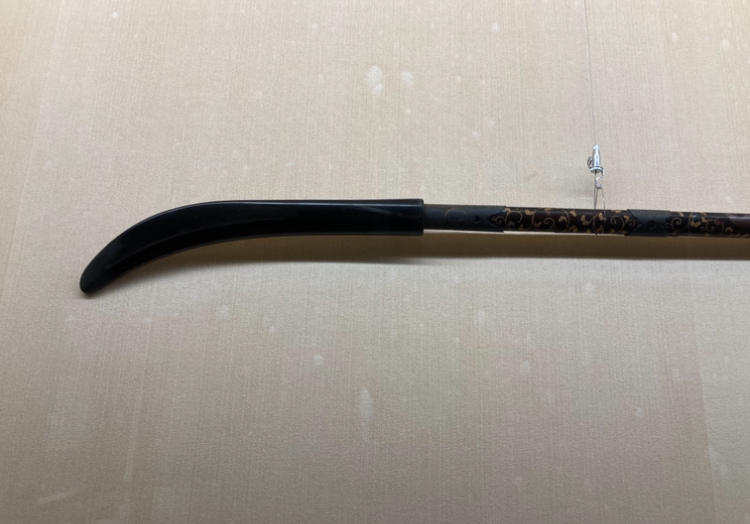
- これは薙刀(なぎなた)で、長い柄の先に湾曲した刃がついた、日本の伝統的な武器です。その名前は文字通り「薙ぎ払う刀」と訳され、形と機能が似ていることから、西洋の武器であるハルバードやグレイブによく例えられます。
- 薙刀は主に武家の女性(武士の妻や娘)が、護身や家を守るために使っていました。
- 刀が接近戦に向いているのに対し、薙刀は長い柄を活かして相手との距離を保つことができます。
- 柄の長さがてこの原理のような力を生み出すため、体力に自信がない人でも効果的に使うことができました。
- 実は、このことをお話しすると、多くの女性のお客様が非常に興味を持ち、喜んでくださいます。
- それはおそらく、この武器が女性に使われていたからというだけでなく、武器でありながらも、その優美で流れるような美しい形状にも理由があるのかもしれません。
- どの侍の家でも、薙刀は誇らしげに飾られており、侍社会の誰もが、いざという時にはこれが使われることを知っていました。
- 実際に使われることがなかったとしても、薙刀は理想的な防御の武器とされていました。そこにあるだけで、まるで守護神のように、圧倒的な防御力を静かに示していたのです。
- だからこそ、薙刀の本当の意味を知ったとき、女性のお客様が微笑まれるのかもしれません。
- きっと本能的に安心感を覚えるのでしょう──この武家屋敷はしっかり守られているって、今でも!

《英語》
- That’s a naginata, a traditional Japanese weapon with a curved blade on a long handle.Its name literally translates to “mowing sword,” and it is often compared to a halberd or glaive in Western weaponry due to its similar form and function.
- The naginata was primarily used by samurai women (the wives and daughters of samurai families) for self-defense and to protect their homes.
- Unlike swords, which are made for close-quarters combat, the naginata’s long handle allowed the user to keep their distance from an opponent.
- As the long handle provided leverage, even a less physically powerful person could use it effectively to fend off an attacker.
- We find that many of our female guests are very interested in and pleased by this fact.
- Perhaps it’s not just because the weapon was used by women, but also because of its beautiful, graceful, flowing shape—a surprising trait for a weapon.
- Every samurai’s home proudly displayed a naginata, and everyone in samurai society knew it would be used in times of crisis.
- Even if it was never actually used, the naginata was considered an ideal defensive weapon.Its mere presence conveyed formidable protective power—like a guardian deity quietly standing watch.
- Perhaps that’s why our female guests often smile when they grasp the naginata’s true significance.
- They might instinctively feel reassured—after all, this samurai house is clearly well-defended, even today!
2.3 日本庭園
👉多くのインバウンドはネットや口コミでこの庭園の存在は事前に知っていて、これが目当てで来た人も多いようで、ああ、これがそうか、といった感じで、大人しく雑談しながら暫く濡れ縁に座っている風景をよく見ます。ただ黙って一緒に縁側に座っていて宜しいと思いますが、いつも通り、インバウンド視点の質問に備えて、いくつか並べてみました。
Q1.背景:この庭の水はどこから引いているのですか?
“Where does the water for this garden come from?”
ここの庭の特徴の一つは、日本庭園でよく見るちょろちょろ流れる曲水でなく、大きな音を立てる曲水ですので、その辺りを背景として置いてみました。

10文の前半(No1-5)は説明にも使える真面目パート、後半(No6-10)は雑談力アップ用のおふざけパートになりますが、No.7,8は通常の説明にも使えますので,その辺りはお相手の興味どころに合わせてお試しください。👉英語音声は、武士の栄光を伝えるのに最適な大英帝国の末裔の男性話者です。👄本パート表現の習得用演習ツールご利用はこちらへ!
《日本語》
- この、かつての武家屋敷界隈には大きな用水路が整備されてきました。
- 元々この用水はこの辺りに武家屋敷が作られ始めた頃の木材運搬に使われたそうです。
- その後、その用水から多くの武家屋敷が自らの庭園に水を引いて曲水を作りました。
- ここの庭園もその一つですが、この家の前の水路はその名残と言えます。
- この家がこのように復元される前は千坪ほど(約3000平米)の大邸宅だったそうです。
- そうなると元々の庭はこれより大きいものだったでしょう。
- 初期のものより遥かに小さくなったわけですが、それでも武士らしい迫力を感じますね。
- この庭園の設計思想は文化人でもあった著名なサムライから来ているそうで、そのせいかもしれません。
- ちょろちょろ流れる貴族庭園と違った快活な音を立てる曲水はいかにも武家の庭園といった感じです。
- でも、電気を使った滝は、武士の衰えた力を感じさせませんか?
《英訳例》
- A large irrigation canal has been maintained in this former samurai residence area.
- Originally, this irrigation canal was used to transport lumber when samurai residences were first constructed in this area.
- Over time, many samurai residences including this one utilized the water from this canal to create their own gardens.
- The garden here is one such example, and the waterway in front of the house is a remnant of this.
- Before the house was restored in this way, it was a large mansion of about 1,000 tsubo (about 3,000 square meters).
- Then the original garden would have been larger than this.
- It is much smaller than the earlier version, but still has a samurai-like power.
- The design philosophy of this garden came from a prominent samurai who was also a cultural figure, and perhaps this is why.
- Unlike the tranquil aristocratic gardens with slow-flowing water, Kyo-ku-sui, featuring a meandering stream, creates a lively ambiance, reminiscent of a samurai’s garden.
- But doesn’t the electrically-powered waterfall evoke the feeling of the lost power of samurai?
Q2 濡れ縁(ぬれえん)🌳この小さな庭の何にこんなに惹かれるのでしょうか?
“What is it about this little garden that attracts us so much?”
冒頭で、言葉はなくてもと書きましたが、それでも名画を観て(その人なりに純粋に楽しめば良いわけですが)何が素晴らしいのか、何が評価されているのか、戸惑う人もいるかもしれません。その辺り、何が腑に落ちるかわかりませんが、10文の前半(No1-7)は説明にも使える真面目パート、後半(No8-10)は雑談力アップ用のおふざけパートで置いてみましたので、現場で使えそうだと思った際にお試しください。👉英語部分は日本人と同じくらい庭園好きの英国女性に語っていただきます。👄本パート表現の習得用演習ツールご利用はこちらへ!

《日本語》
- 庭は狭いですが、各構成要素が密に立体的に配置されているため、広く見え、開放感があります。
- 樹木、灯籠、庭石、曲水の構成物がバランスよく配置されているので統一感、安定感があります。
- 曲水の中を泳ぐ鯉の静かさと躍動感のある滝の音がお互いを邪魔することなく調和しています。
- 狭さ故、散歩用でなく濡れ縁から観賞できるように作られいて、見ている人に迷いを与えません。
- 目の前の大きなヤマモモの樹齢は400年を超えています。
- 野村家初代当主は当時、故郷に生えている植物を植えて育てようとしたそうです。
- 気候も土壌も合わず、殆どが上手く育ちませんでした。
- この木は生き残った数少ない植物の一つですが、この小さな庭の守り神のように見えます。
- 初代当主の様にこの控え目な木でこの庭園を守ったのかもしれません。
- とても美しい高価な松を植えていればこの庭は高値で売られていてこの様に存在していなかったかも。
《英訳例》
- Although the garden is narrow, the dense, three-dimensional arrangement of each component makes it appear larger, thus creating a sense of spaciousness.
- The well-balanced arrangement of components like trees, lanterns, garden stones, and kyo-ku-sui (meandering stream) imparts a feeling of unity and stability.
- The carp glide silently through the stream, their quiet movement harmonizing with the lively cascade of the waterfall.
- Due to its narrowness, it is designed for viewing from the open verandah rather than for strolling, ensuring that the viewer never feels disoriented.
- The large mountain myrtle tree( a kind of myrica)in front of you is over 400 years old.
- The first head of the Nomura family tried to plant and grow plants that grew in his hometown at that time.
- The harsh climate and unforgiving soil proved a challenge, claiming most of the transplanted species
- This tree, one of the few that survived, appears to be the guardian deity of this small garden.
- Perhaps this modest tree, a survivor of adversity, serves as a silent guardian, reflecting the spirit of its planter.
- If he had planted very beautiful and expensive pine trees, this garden would have been sold for a high price and would not exist like this.
Q3:山桃の実🍓公式HPにある400年のヤマモモの木はどれ?
“Which one is the 400-year-old wax myrtle tree featured on the official website?“
実際によく聞かれる質問をベースに山桃の木に関する表現を織り込んでみました。いつも通り前半(1-5)は説明にも使える真面目パート、後半(6-10)は雑談力upの為のおふざけパートです。👄本パート表現の習得用演習ツールご利用はこちらへ!

《日本語》
- こちらがヤマモモの木です。日本語で「山桃」と書き、文字通り「山の桃」と呼ばれています。
- 日本の山地に自生する在来種で、赤い実は大きなイチゴのような形をしています。
- 植物学的にはヤマモモ科に属し、学名は Myrica rubra。中国ヤマモモやワックスマートルとも呼ばれています。
- 実はジューシーでほのかな酸味があり、生のまま食べたりジャムに加工されたりします。
- この木は通常、環境や手入れ次第で数十年から百年以上生きると言われています。
- この地域では冬の寒さが厳しいため、この庭で元気に育っているのは非常に珍しいことです。
- おそらく、代々の家族がこの木を大切に守り続けてきたのでしょう。初代の当主が故郷から持ち込んだ、唯一現存する生きた遺産なのです。
- 現在も実をつけるかどうかは分かりませんが、それは重要ではありません。
- なぜなら、この木は今、別の実りをもたらしてくれているからです。この質素な庭が放つ静かな美に、世界中の訪問者が心を動かされているのです。
- その感動は、まるで実物の果実のように、ジューシーでほろ酸っぱく、やさしく心に染み入るものかもしれません。
《英語》
- This is the wax myrtle tree, known in Japanese as Yamamomo, which literally means “mountain peach.”
- It’s a native Japanese species that grows in the mountains and produces red fruit that resemble oversized strawberries.
- Botanically, it belongs to the Myrica family—its scientific name is Myrica rubra, and it’s also called Chinese bayberry or wax myrtle.
- The fruit is said to be juicy and slightly tart, often enjoyed fresh or made into jam.
- Typically, these trees live for several decades to a century, depending on climate and care.
- So it’s quite rare to find one thriving in this garden, given the region’s harsh winter conditions.
- Perhaps generations of this household have lovingly protected it—preserving a precious living legacy brought here long ago by the family’s first head.
- I’m not sure if this venerable elder still bears fruit, but that hardly matters.
- Because this tree now offers a different kind of harvest: it moves visitors from all over the world with the quiet beauty of this unpretentious garden.
- To many, it may even feel as if the intangible fruit—like its spirit—is just as vivid and tart and tender as the real thing.
2.4 上段の間/謁見の間
サムライ屋敷に一体何故?領主をお招きする為の上段の間が?と思うのは、かなりお詳しい方で、殆どのインバウンドは(日本人観光客の多くもですが)、この屋敷の雰囲気に浸かっていますので、その辺りの細かい質問はそれほど多くないようです。ここでは、この部屋はそもそも何?(What?)、どのように使われるの?(How?)への対応がメインかと思います。また、建築質問も多いので、その辺りの表現を意識して組んでみました。

Q1:目的:この部屋は何をする為のものだったのですか?
”What was this room used for?”
ここでは10文の前半(No1-7)は説明にも使える真面目パート、後半(No8-10)は雑談力アップ用のおふざけパートで置いてみましたが、No2~No5は日本歴史マニアインバウンド向けにと思います。
《日本語》
- これはVIPルームで、「上段の間」として知られ、藩主を招くために設けられた部屋です。家の他の部分より一段高く作られ、その重要性を表しています。
- 上段の間という建築様式は、約400年前に武家屋敷で始まりました。もともと、藩主が家臣と会うために自邸にこのような部屋を設けたのです。
- そのため、このような部屋は野村家だけでなく、日本各地の有名な大名邸にも見られます。
- 歴史に詳しい人は、「なぜ野村家に上段の間があるのか」と疑問に思うかもしれません。野村家は藩主の邸宅ではないからです。
- その答えはその歴史にあります。この部屋はもともと野村家の一部ではなく、19世紀半ばの修復時に関連する大名邸から移築されたものです。
- これらの部屋は、黒檀や黒紫檀といった高価な材料を使い、大胆かつ精巧な技術で作られています。
- こうした「上段の間」では、高貴な人が直接見られないように部屋に竹の簾(すだれ)が掛けられることが一般的でした。
- 当然ながら、貴族や藩主は外の庶民から姿を見られることを望みませんでした。
- 現代の日本では、同様の簾が多くの小さな家でも見られ、主にプライバシーを保つために使われています。
- ただし、現在これらの簾を使う多くの理由は実用目的で、家の中や室内干しの洗濯物を外から隠すためです。
《英訳例》
- This was a VIP room, known as a Jodan-no-ma, designed for inviting feudal lords. It was built one step higher than the rest of the house to signify its importance.
- The upper-level room is an architectural style that originated about 400 years ago in samurai residences. Originally, lords included such rooms in their own homes to meet with their vassals.
- Therefore, you can find similar rooms not only in the Nomura House but also in the residences of famous daimyo (feudal lords) throughout Japan.
- Historians might wonder why an upper-level room exists in the Nomura House, given that it was not the residence of a lord.
- The answer lies in its history—this room was not part of the original Nomura House but was moved from a related daimyo’s mansion during restoration in the mid-19th century.
- These rooms are boldly and exquisitely crafted using expensive materials, such as ebony and black ebony, and feature elaborate techniques.
- In such audience halls, bamboo blinds were often hung over the room to prevent the nobleman inside from being seen directly.
- Naturally, nobles and lords did not want to be visible to the common people outside.
- In modern Japan, you can find similar screens in many small houses, primarily used to maintain privacy.
- However, the reason for using these screens today is often practical—to hide the inside of small homes and laundry drying indoors from view.
Q2:格天井(ごうてんじょう):この天井は何か特別なんですか?
“Is there anything special about this ceiling?”
ここからは、素材(部材)と工法のポイントをご紹介します。どこまで説明するか悩ましいところですが、基本的には、何がすごいのか自体よくわからないはずなので、何かが目に留まったと気づいたときにワンポイントでコメントする想定で置いてみました。10文の前半(No1-6)は説明にも使える真面目パート、後半(No7-10)は雑談力アップ用のおふざけパートで置いてみました。

《日本語》
- この天井は、大広間によく見られる工法で作られており、高い格式を象徴しています。
- 細長い木材で格子状の骨組みを作り、その上に裏板を取り付ける構造になっています。
- さらに、この天井は「格天井」と呼ばれる最高級の天井で、平らではなく、上面が凹型になっているのが特徴です。
- この様式は、ヨーロッパのルネサンス建築の天井にも見られ、部屋を実際より広く見せる効果があります。
- 天井の空間にはさまざまな装飾や彫刻を施すことができ、部屋に豪華な雰囲気を与えます。
- この天井には、日本で古くから用いられてきた最高級の木材のひとつである檜が使われています。
- 檜はその美しい白色、光沢、そして独特な香りから、今でも高級建築に使用されています。
- 現在でも裕福な人々は、自宅に檜風呂を設け、その香りを楽しんでいます。
- 実際、檜の香りには脳を落ち着かせ、自律神経を安定させる効果があると言われています。
- 結局、こんな立派な檜の天井を設えることで、侍たちは殿の怒りが切腹の命令にまで発展しないことを願っていたのかもしれませんね!


《英訳例》
- This ceiling is constructed using a method commonly seen in grand halls, symbolizing high status.
- It features a lattice-like framework made of long, thin wooden pieces, with a backing board attached to it.
- Furthermore, this is a coffered ceiling—the highest class of ceiling—characterized by its concave upper surface rather than a flat one.
- This style is also found in Renaissance architecture in Europe and has the effect of making a room appear larger than it actually is.
- Various decorations and carvings can be added to the open spaces within the ceiling, enhancing the luxurious atmosphere of the room.
- This ceiling is made of hinoki cypress, one of the finest types of wood used in Japan since ancient times.
- Hinoki cypress remains a popular material in high-end construction today due to its beautiful white color, natural luster, and unique fragrance.
- Even now, wealthy individuals install hinoki cypress baths in their homes to enjoy its soothing aroma.
- In fact, the scent of hinoki cypress is said to have a calming effect on the brain, helping to stabilize the autonomic nervous system.
- After all, by installing such fine Hinoki cypress overhead, people in the Samurai era might have hoped it would keep their lords from getting angry enough to order seppuku(ritual suicide)!


Q3:桐の床板:この畳も特別なのですか?
“Is this tatami mat special as well?”
ここでは公式サイトにもあります桐の床板で纏めました。10文の前半(No1-4)は説明にも使える真面目パート、後半(No5-10)は雑談力アップ用のおふざけパートです。

《日本語》
- この畳だけでなく、その下の床板も特別な造りになっています。
- 床板には、高級箪笥でよく使われる桐の板が張られています。
- 長さ六尺もある桐板が使われているのでさらに調達が大変で高価なものです。
- 桐は木を食べる虫を寄せ付けない成分がありますので、タンス素材に最適です。
- では何故、そんな高級な桐の素材をフローリングに使ったのでしょうか?
- 理由は色々考えられますが、桐の床板は冷たくならないからだという説があります。
- 桐の内部は空気を多く含み、熱を伝えにくいため、スポンジのように寒さに強いのです。
- しかし、空気を多く含むため弱く、傷がつきやすく、フローリングには不適でなのです。
- つまり、桐の床板は、表面を傷つけることなく優雅に足を踏み入れることができる高貴な人に向いているわけです。
- 悲しいことに、桐はカビや虫だけでなく、私たちのような庶民も寄せ付けないということなんですね。
《英訳例》
- Not only is the tatami mat special, but the floorboards beneath it are also uniquely crafted.
- The floorboards are covered with paulownia wood, a material often used in high-end chests.
- Using six-foot-long paulownia boards makes them even harder to source and significantly more expensive.
- Paulownia wood has a component that keeps wood-eating insects at bay, making it an ideal material for chests of drawers.
- So why would such high-quality paulownia wood be used for flooring?
- There are many possible reasons, but one theory suggests that paulownia floorboards are chosen for their ability to retain warmth.
- The interior of paulownia wood contains a lot of air, which doesn’t conduct heat easily, making it resistant to cold, much like a sponge.
- However, its high air content renders it weak, easily scratched, and unsuitable for flooring.
- Thus, paulownia floorboards are best suited for noble individuals who can tread gracefully without harming the surface.
- Sadly, this suggests that paulownia wood can repel not only mold and pests but also commoners like us.
👄本パートの常連様向け演習ツールはこちらへ!
Q4. ガラス障子:このガラス障子も当時のものですか?
“Is this glass shoji screen also from that time?
ここでは上段の間や庭に目を奪われがちで比較的地味な存在のガラス障子をカバーします。10文の前半(No1-5)は説明にも使える真面目パート、後半(No6-10)は雑談力アップ用のおふざけパートです。

《日本語》
- 中から庭を見ることができるガラス入りの障子は当時のものです。
- 現代のものと見間違えるほどの障子なので2百年前は驚きの対象だったでしょう。
- 日本では古くから窓には和紙を素材とする障子を使っていました。
- 障子は風を防ぎながら適度に光を通し部屋を明るくするのでとても便利です。
- それでもガラスの様にドアを閉めたまま外を見ることはできません。
- でもこの裕福な野村家は高価だけど便利な透明なガラスを何故増やさなかったのでしょうか?
- 障子と違って、雨も弾き風も通さないのに光を全て通し、しかも周りに自慢もできるこのガラス。
- ガラスの導入は西洋化の象徴なので、これが普及することはサムライ時代の終焉も意味していたわけです。
- それを予見していたかのように彼らは結局、ここをガラス張りの屋敷にはしませんでした。
- その代わり世界的に有名になった大人気のこの屋敷は世界中のネットの目からガラス張りです。
《英訳例》
- The glass-filled shoji screens that allow you to see the garden from inside were made in those days.
- The shoji screens, which could be mistaken for modern ones, would have been an object of amazement two hundred years ago.
- In Japan, shoji screens made of washi paper have been used as window coverings since ancient times.
- Shoji screens are highly practical, as they block wind while allowing enough light to illuminate the room.
- However, unlike glass, they do not allow you to see outside while keeping the door closed.
- But why didn’t the wealthy Nomura family opt for adding more expensive yet convenient clear glass?
- Unlike shoji screens, this glass repels rain, keeps out wind, allows all light to pass through, and can be proudly displayed to those around it.
- Since the introduction of glass was a symbol of westernization, its widespread use also signaled the end of the samurai period.
- As if foreseeing this, they decided against turning the place into a glass house after all.
- Instead, this very popular samurai mansion, which has gained worldwide fame, became another glass house open to the eyes of people in the Net world!
👄本パートの常連様向け演習ツールはこちらへ!
Q5.襖絵&牡丹:この襖絵には何の花が描かれているのですか?
“What kind of flower is depicted in this fusuma painting?”
保護用のガラス越しなので、優雅さそのまま伝えることは難しいかもしれませんが、せめてトークでカバーできれば良いですね。10文の前半(No1-6)は説明にも使える真面目パート、後半(No7-10)は雑談力アップ用のおふざけパートです。ここでは牡丹に関する説明ネタと関連表現が学べます。
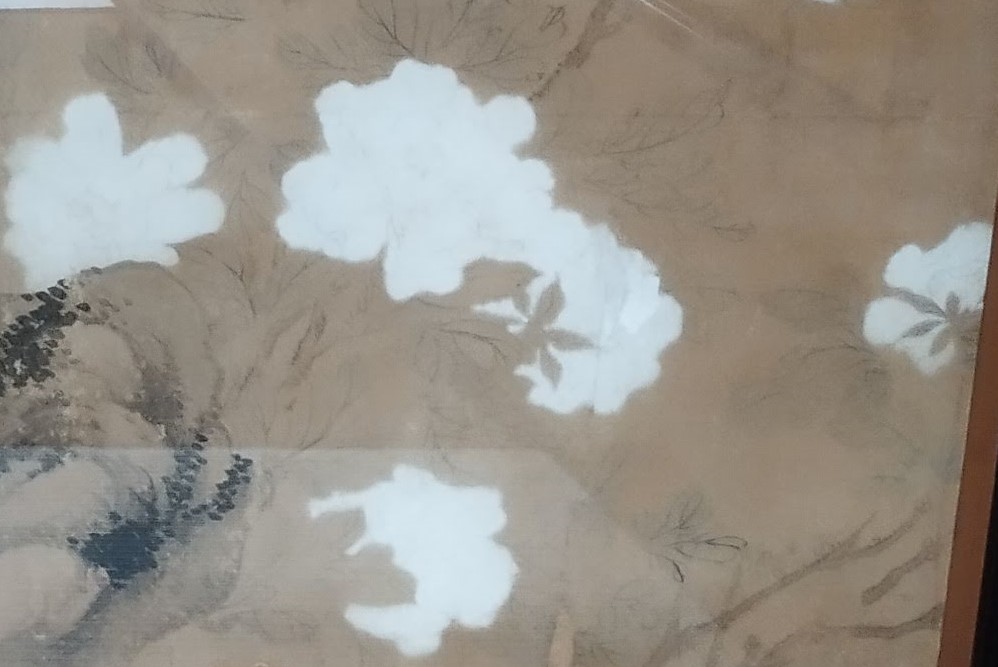
《日本語》
- 襖絵には、伝統的な水墨山水画と、当時の最高の画家によって描かれた白い牡丹が描かれています。
- 牡丹の花言葉は「優雅」と「富」であるため、牡丹は大名屋敷の襖絵によく描かれることがありました。
- 興味深いことに、牡丹は侍階級においては不吉な花と考えられていました。通常、多くの花は枯れるとき、花だけでなく植物全体が徐々に衰えていきます。
- しかし、牡丹は花びらが重すぎて自重を支えきれず、花が落ちる一方で茎はそのまま残ります。
- 花びらが一斉に散る様子は、敗れた侍の首が落とされる姿を連想させました。
- それでも、美しい花びらが一緒に落ちる様子は、強さと儚さの両方を伝え、牡丹を絵画の題材として人気のあるものにしました。
- 中国では、牡丹の原産地であり、牡丹は「花の王」または「花神」と呼ばれています。一輪の花だけでも贅沢な雰囲気を作り出すからです。
- 桜や梅のように、多くの花や枝を必要とする絵と異なり、牡丹はたった一輪で美しい絵を作り出すことができます。
- 画家が桜や梅の花を描く際には、しばしば多くの花や枝を描く必要がありましたが、牡丹の場合は一輪で十分でした。
- この見た目が軽そうな作業量が、この家の多くの襖絵を飾ることを任された有名な画家が牡丹を選んだ理由なのかも!
《英訳例》
- The fusuma paintings depict traditional monochrome landscapes and white peonies painted by the best painters of the time.
- Since the symbolic meanings of peonies are “elegance” and “wealth,” they are often depicted on fusuma paintings in the residences of lords.
- Interestingly, peonies were considered unlucky flowers among the samurai class. Typically, when most flowers wither, both the flowers and the entire plant gradually decline and die.
- Peonies, however, have such heavy petals that they cannot support their weight, causing the flowers to fall off while the stem remains intact.
- The sudden and simultaneous shedding of petals reminded people of the severed heads of defeated samurai.
- Yet, the sight of the delicate petals falling together conveys both strength and transience, making peonies a popular subject for paintings.
- In China, their country of origin, peonies are called ‘the king of flowers’ or ‘the flower god’ because even a single bloom in a vase can create a luxurious atmosphere.
- Unlike cherry blossoms or plum blossoms, which require many flowers and branches to create a beautiful painting, peonies can create a stunning image with just one flower.
- While painters often needed to depict numerous flowers and branches for cherry or plum blossoms, a single peony was sufficient.
- This seemingly lighter workload might be why the famous painter, tasked with decorating so many fusuma panels in this house, chose peonies!
2.5 一階座敷
Q1. 鍵隠し:この装飾品は何なんですか?
“What are these ornaments?”

座敷の釘隠しの展示は目を引きますので、黒柿情報とその辺りの英語表現を織り込んだ説明ネタです。全10文の前半は説明にも使える真面目パート(1-7)と雑談力upの為の後半おふざけパート(8-10)に分かれています。👄下記10文の演習ツールご利用の際はこちらへ!
《日本語》
- これは、釘の頭を隠すために使用される装飾品です。
- 多くの日本の家では、さまざまなデザインで室内のアクセントとして使われています。
- 特に、これらは金属ではなく、希少な黒柿の木で作られています。
- 黒柿とは、樹齢100年以上の柿の木に現れる黒い模様の部分を指します。
- その耐久性、独特な色合い、美しい木目が評価され、高級家具にも使用されています。
- 一般的な釘隠しは、金型を使って低コストで大量生産できる金属材料がよく使用されます。
- しかし、これらの木製の装飾品は熟練した職人が一つひとつ手彫りで作る必要があり、その価値を高めています。
- 英語では「to drive a nail(釘を打つ)」という表現が、仕事を完了するという意味で使われます。
- しかし、日本では釘を打つだけでは仕事が完了したとはみなされません。
- 釘が丁寧に隠されて初めて、仕事が完了したとされるのです。to drive a nail(釘を打つ)だけではないのですよ!
《英語》
- These are ornaments used to conceal nail heads.
- In many Japanese houses, they serve as decorative accents, available in various designs.
- Notably, they are made from rare black persimmon wood, not metal.
- Black persimmon refers to the black-patterned part of persimmon trees that appears after more than a hundred years.
- Valued for its durability, unique coloration, and beautiful grain, black persimmon is also used in high-end furniture.
- Ordinary nail head covers are often made from metal, which can be mass-produced using molds at a lower cost.
- However, these wooden ornaments must be individually hand-carved by skilled artisans, enhancing their value.
- In English, the expression “to drive a nail” means to complete a task.
- However, in Japan, driving a nail doesn’t signify the job is complete.
- The task is only finished when the nail is carefully concealed—not simply by driving it in.
2.6 一階廊下
Q1. 聲桶(こうけい)🐤これは何のための箱ですか?
“What is this box for?”

多くの訪問客は庭の縁側に気を取られていますので、その自然な流れを止めない様にこちらから積極的に説明することはありませんが、実際、この箱が気になって質問するゲストも多いのでその辺りを踏まえ、鳥用語も織り込んだ説明ネタです。全10文の前半は説明にも使える真面目パート(1-5)と雑談力upの為の後半おふざけパート(6-10)に分かれています。🐤本パートの演習用音声ツールはこちらから。
《日本語》
- これは、ウグイスの鳥かごを収めるために作られた桐の箱です。ウグイスの美しい歌声をより際立たせるためのものでした。
- 日本のウグイスは、その美しい鳴き声で春の訪れを告げる鳥として、何世紀にもわたり日本人の心の中で特別な存在でした。
- 平安貴族の時代に遡ること千年以上前から、日本では「鶯合(うぐいすあわせ)」という遊びが行われていました。これは、春にウグイスをかごに入れ、その歌声の美しさを競い合うものです。
- さらに、桐は古代中国から鳥のための神聖な木とされてきたため、このような箱を用いることは、鳥への深い敬意と愛情の表れでもありました。
- もちろん、現代の日本では、動物愛護の観点からこの習慣はほぼなくなりました。
- 実際に、この桐の箱を直接ご覧になる方の中には、ウグイスをかごに入れる行為を残酷だと感じたり、心を痛めたりする方もいらっしゃいます。
- 歴史的には、飼育係が鳥の適切な換気を確保していましたが、一見すると密閉された箱が現代の訪問者にとって心を痛めるように映るのも無理はありません。
- 正直なところ、お客様から尋ねられない限り、この箱について私から積極的にご説明することはあまりありません。
- 一つには、動物虐待のような印象を与えたくないからですが、実はもう一つ、少し不都合な真実があるんです。
- それは単に、どうしようもない矛盾を浮き彫りにしてしまうのではないかと心配しているからです。ここで、日本人が鳥を虐待していたわけではないと言っているのに、同時に日本中でしっかり焼かれ串刺しされた焼き鳥を心ゆくまで楽しんでいるという、ね。
≪英語≫
- This is a paulownia wood box designed to hold the birdcages of bush warblers, enhancing the beauty of their songs.
- The Japanese bush warbler has held a special place in the hearts of the Japanese people for centuries, announcing the arrival of spring with its beautiful call.
- Dating back over a thousand years to the aristocratic age, the Japanese practiced “Uguisu-awase,” a competition where they would cage bush warblers in spring and vie for the most beautiful songs.
- Moreover, paulownia has been considered a sacred tree for birds since ancient China, so using such a box also reflected a profound respect and affection for these creatures.
- Of course, in modern Japan, this custom has largely disappeared due to animal welfare concerns.
- Indeed, some visitors who see this paulownia box in person may find the practice of caging bush warblers to be cruel or distressing.
- Historically, caretakers ensured the birds had proper ventilation, but it’s understandable how a seemingly closed box might appear distressing to modern visitors.
- Let’s just say I don’t always volunteer information about this box unless asked.
- Part of it is to avoid any impression of cruelty, but there’s also a somewhat inconvenient truth.
- I’m afraid it might simply highlight an unsolved paradox: that we’re here saying the Japanese weren’t abusing birds, while simultaneously enjoying perfectly grilled and skewered yakitori all across the country.
2.7 二階 茶室
茶室も野村家のメインアトラクションで、多くの訪問客に見たままで楽しんでいただけますものの、やはりある程度はご説明しないとその真意が伝わらない点も多いので、実際によく質問される内容をベースに纏めてみましたので、ここもお相手の反応を見ながら使えそうなフレーズあれば現場でもお試しください。

Q1.茶室の背景:この部屋でお茶はどうやって飲むんですか?
“How do people have tea in this room?”
茶室にご案内すると実際によく聞かれる質問ですが、茶道について何も知識がないとお茶を飲む姿のイメージがわかないのでしょうね。全10文の前半は説明にも使える真面目パート(1-6)と雑談力upの為の後半おふざけパート(7-10)に分かれています。
《日本語》
- 当時、大名や上級武士の間では、自宅に茶室を持つことが流行していました。
- 武芸だけでなく、洗練された知的な趣味を持っていることを示したかったのです。
- この茶室が利用可能で興味があれば、実際にここでお茶を体験することもできます。
- 畳の上に座り、庭の曲水の音を聞きながらお茶を楽しめます。
- 正座が苦手な場合は、楽な姿勢で座っていただいて構いません。
- この茶室は2階にあるので、窓から静かな庭を眺めるのもおすすめです。
- 2階に茶室があるのは非常に珍しいことです。実際、京都の有名なお寺にも2階茶室があり、それが目玉の一つとなっています。
- 興味深いことに、野村家はこのユニークな茶室を積極的に宣伝していません。それは、侍に典型的な控えめな態度を反映しているのかもしれません。
- しかし、当時侍は商人から「ビジネス下手」や「宣伝力に欠ける」と揶揄されることもしばしでした。
- もしこの家の住人が商人たちがどう思っていたか知っていたら、”It’s none of your business!”「余計なお世話だ!」と答えたかもしれませんね。

《英訳》
- It was fashionable during the time of the daimyo lords and high-ranking samurai to have tea rooms in their residences.
- They wanted to showcase not only their martial arts skills but also their refined intellectual tastes.
- If this tea room is available and you’re interested, you can even experience tea here.
- You can enjoy tea while sitting on the tatami mat and listening to the sound of the curved stream in the garden below.
- If sitting in seiza (the formal Japanese sitting position) is uncomfortable, you’re welcome to sit at ease instead.
- Since this tea room is on the second floor, we also recommend gazing out the window at the serene garden.
- Having a tea room on the second floor is quite rare. In fact, even a famous temple in Kyoto boasts a second-floor tea room as one of its key attractions.
- Interestingly, the Nomura house doesn’t actively promote their unique tea room, which might reflect the modesty often associated with samurai.
- However, samurai were often ridiculed by merchants for lacking business acumen or promotional skills at the time.
- If the residents of this house had known what merchants thought of them, they might have responded with, “It’s none of your business!”
Q2. 茶室の入口:どうして入口がこんなに狭いんですか?
“Why is the entrance so narrow?”
これもよく聞かれる質問で、Q1と同じく茶道の世界を知らないインバウンドには一目見て素朴に思うのでですね。全10文の前半(1-6)は説明にも使える真面目パート、後半(7-10)は雑談力UPの為のおふざけパートです。今回は茶道確立時期に日本に伝わったキリスト教に関する表現を織り込んでみました。

《日本語》
- 茶道では、入口が意図的に狭く作られており、ゲストが武器や荷物を持ち込まないようにし、頭や上半身を下げて入る必要があるようになっています。これには平等を象徴する意味が込められています。
- 部屋の中では、主人と客の席順は通常役割によって決められ、身分に基づくものではありません。このことは平等主義的な思想を反映しているとも言えます。
- 茶道の基本原則は、身分や財産が関係なく、誰もが平等に扱われ、お茶を楽しむことができるようになっています。
- 武士の時代、社会は厳格な身分制度に基づいており、武士はその頂点に位置していました。
- そんな中で、身分を問わない茶道が武士階級に広まったのは非常に興味深いことです。
- 特に約500年前の戦国時代には、武士たちは常に戦で命を落とす危険と隣り合わせでした。そのような中で、茶道は非日常的な平等とおもてなしの世界を生み出したのかもしれません。
- また、別の説では、キリスト教の平等思想が茶道に影響を与えたと言われています。
- ちょうど茶道の習慣が確立される頃、スペインやポルトガルからキリスト教が日本に伝えられました。
- しかし当時の支配者たちは、キリスト教を危険な思想とみなし、禁教令を出しました。
- もしこの説が真実で、キリスト教が禁じられなかったなら、茶道の名前は全く違ったものになっていたかもしれません。「茶道」ではなく、「クリスチャニティーセレモニー」に!
《英訳》
- In tea ceremonies, the entrance is deliberately made narrow to ensure that guests do not bring in weapons or belongings and must lower their heads and upper bodies to enter, symbolizing equality.
- Inside the room, the seating arrangement for hosts and guests is typically determined by roles rather than social class, reflecting an egalitarian philosophy.
- The fundamental principle of the tea ceremony ensures that status or wealth is irrelevant, allowing everyone to be treated equally and enjoy tea together.
- During the era of the samurai, society was highly stratified, with samurai at the top of the hierarchy.
- It’s fascinating that the tea ceremony, which disregards social status, became popular among the samurai class.
- Particularly during the civil war period about 500 years ago, when samurai lived with the constant risk of losing their lives in battle, the tea ceremony may have created an extraordinary world of equality and hospitality.
- Another theory suggests that the egalitarian ideals of Christianity influenced the tea ceremony.
- Around the time the customs of the tea ceremony were being established, Christianity was first introduced to Japan by Spain and Portugal.
- However, the ruling authorities of the time banned Christianity, viewing it as a dangerous ideology.
- If that theory is true and Christianity had not been banned, the name of the tea ceremony might have been quite different. Instead of a “Tea Ceremony,” we might be calling it a “Christiani-tea Ceremony”!
Q3. 茶室の天井:随分変わった造りの天井でないですか?
“Isn’t it a very unusual ceiling structure?”
建築に興味があるインバウンドも多いので、気が付かない場合も含めて、ご説明すると喜ばれる箇所。全10文の前半(1-6)は説明にも使える真面目パート、後半(7-10)は雑談力UPの為のおふざけパートです。今回は茶道、美意識、木に関する表現をできるだけ織り込んでみました。
《日本語》
- その美に気が付くなんて鋭い眼をお持ちですね、殆どの人は見過ごしますのに。
- この天井は二層に重ねられたユニークな構造で、上が杉で下地が桐板なんです。
- それで杉の節穴から下層の美しい桐が見えます。
- 桐は、反りや寸法変化に強く、いつまでも美しい外観を保つことができるため珍重されています。
- ここで使われている希少な杉は「神代杉」と呼ばれています。
- この杉は何百年もの間、火山灰のように地中に埋もれていました。その間に水分を失い、魅惑的な光沢を放つようになりまりました。
- 茶道では、この「節穴」のような珍しい素材を鑑賞できるかどうかで、客の美意識を評価されることがありました。
- この「節穴」の価値を理解できない客は、日本では「節穴の」ような目をした人、と軽蔑の目で見られることもありました。
- だから今日、あなたのような洗練された審美眼を持つゲストにこの説明をお伝えするのです。
- だって私も節穴の目をしたガイドと思われたくありませんので。

《英訳例》
- You have a keen eye for noticing and appreciating such beauty, as most people overlook its subtle charm.
- The ceiling features a unique construction with two layers, using cedar on top and paulownia wood beneath.
- This design allows you to catch glimpses of the beautiful paulownia wood through small knotty holes.
- Paulownia wood is prized for its resistance to warping and changes in size, ensuring it maintains its exquisite appearance indefinitely.
- The rare cedar used here is known as ‘Jindai Sugi,’ which means ‘cedar of ancient times.’
- These cedars were buried in the ground like volcanic ash, for hundreds of years. During this time, they lost their moisture and developed a captivating sheen.
- In the tea ceremony, there were instances where a guest’s aesthetic sense was sometimes evaluated based on their ability to appreciate unusual materials such as ‘knotty holes’.
- Guests who could not grasp the value of this ‘knotty holes’ were sometimes viewed with disdain in Japan as a person with eyes like ‘knotty holes’.
- That’s why I’m sharing this explanation with guests who possess a refined aesthetic sense, like you, today.
- After all, I wouldn’t want to be considered a “knotty holes-eyed” guide myself.
Q4. 控えの間:この床板には何か特別な意味や特徴があるのですか?
“Does this floorboard have any special meaning or characteristics?”
床板も多くのインバウンドは気が付きませんので、建築へ興味がありそうな方を想定した千年楓一枚板の説明ネタです。全10文前半の真面目パート(1-5)と後半のおふざけパート(6-10)に分かれています。今回は茶道、遠慮、気遣い、カエデに関する表現をできるだけ織り込んでみましたが、実際はNo1とNo4で殆どのインバウンドは満足されますので、それ以外は雑談力upにご利用ください。👉英語音声は落ちた紅葉なんか関係ない元気いっぱいのオーストラリア女性です。👄下記10文の演習ツールご利用の際はこちらへ!
《日本語》
- 床板は樹齢約千年の紅葉の 一枚板を使っていてとても貴重で珍しいものです。
- 一般的にカエデの木は明るいクリーム色から赤褐色の木目はまっすぐできめは細かく均一で独特の美しさがあります
- また硬く、強く、耐久性に優れ、衝撃に強いため、家具、楽器などに使われていて素材としては珍しいものではありません。
- その樹齢の長さだけでなく、この様な大きな1枚板が取れる紅葉の木はそんなにありませんので二重の意味で貴重です。
- 茶室だけでなく、控えの間にこんな仕掛けをするなんて、野村家は本当にお金持ちだっんですね。
- しかもただのお金持ちだと、珍しい高価な材料を使って見せびらかすだけなんですけど、サムライの見せ方は少し違うのかもしれません。
- 例えば、カエデの木であれば天井に使って、空想の秋の紅葉を見上げて楽しむ趣向なんかできたかもしれません。
- でも、目立たない床板に使ったのは、曲水に落ちた紅葉の葉っぱを見下ろすイメージを意図したのかもしれません。
- 多くの来客、特に殿様の近臣達から、ねたまれないように、カエデの木を選んだのかもしれません。
- カエデの花言葉は遠慮なので千年の孤独ならぬ千年の遠慮を示す為に。
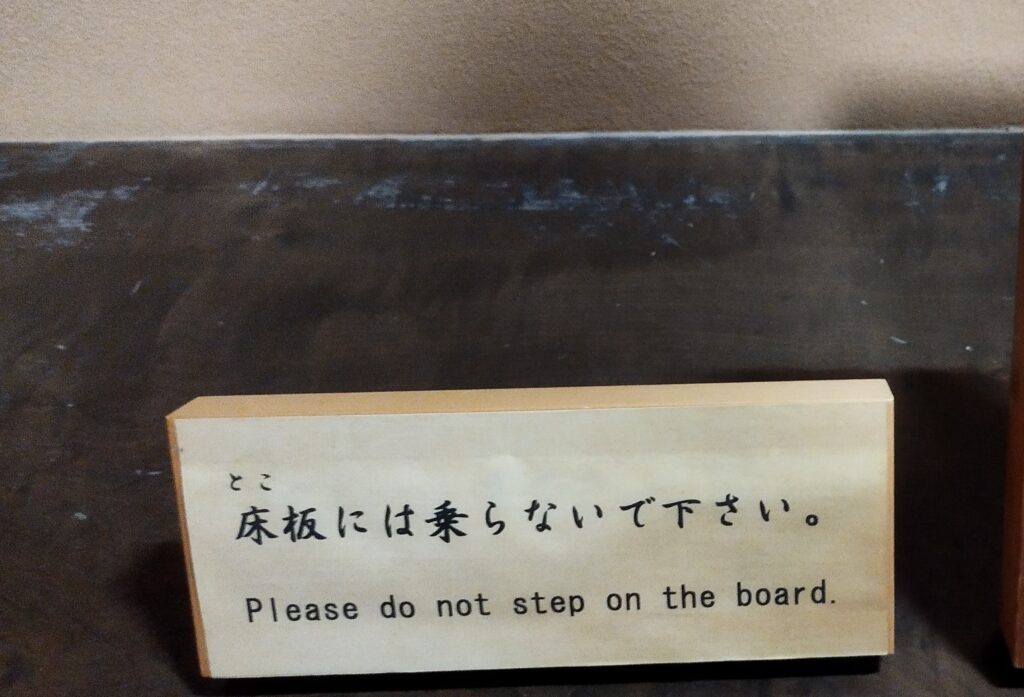
《英訳例》
- The floorboards are made from a single piece of a 1,000-year-old maple tree, which is incredibly precious and rare.
- Maple wood is generally light cream to reddish-brown in color, with a straight, fine, and uniform grain, which gives it a unique beauty.
- Maple wood is commonly used due to its hardness, strength, durability, and impact resistance, making it a popular choice for furniture and musical instruments.
- However, this maple board is not only ancient but also precious in a double sense, as it’s rare to find and procure maple trees large enough to craft such an expansive single piece.
- The Nomura family must have been quite wealthy to have such a contraption not only in the tea ceremony room but also in the antechamber.
- While wealthy individuals often use rare and expensive materials to show off, the samurai’s way of displaying wealth may have been a bit different.
- For example, a maple tree could have been used as a distinctive accent in a ceiling, allowing waiting guests to enjoy the view of imagined autumn leaves.
- On the other hand, the use of inconspicuous floorboards may have been intended to evoke the image of autumn leaves falling into the meandering water of the garden.
- Perhaps the maple tree was chosen to avoid being pestered by many visitors, especially the lord’s lieutenants.
- Since the language of maple flowers symbolizes reservation, could it have been meant to represent a thousand years of restraint, rather than a thousand years of loneliness?
3.『野村家』退館後に聞かれそうなポイント
無事退館した後、ホッとしたいところですが、野村家は観光には絶好の立地にあるので、まだ時間があれば、他になにかない?と聞かれるのは必定なので、下記パターンの対応例をご紹介します。
3.1 好天の場合
《日本語》
- 兼六園か金沢城がお勧めです。
- どちらも1マイル弱で歩いて約20分ほどです。
- 野村家が仕えていた君主の屋敷跡とプライベートガーデンです。
- 君主の裕福さと文化好きがわかります。
《英訳例》
- I would recommend Kenrokuen Garden or Kanazawa Castle.
- Both are just under a mile away and take about 20 minutes to walk to.
- They are the former residence of the monarch served by the Nomura family and a private garden.
- You can see the monarch’s wealth and love of culture.
👉『兼六園全体』の英語案内例にについては別ブログでご紹介しておりますので、もしご興味あればご参照くださいませ。
👉👉『金沢城全体』の英語案内例についても別ブログでご紹介しておりますので、もし何かご入用の際にはご参照くださいませ。
3.2 好天でない場合
- 21世紀現代美術館か近江町市場がお勧めです。
- 前者は約1.2kmで徒歩15分です。
- 後者は巡回バスかタクシーで10分ほどです。
- 現代美術館ができる前は地元では反対が多かったのですが今はとても愛されています。
- パリのエッフェル塔のようですね。
- I would recommend the 21st Century Museum of Contemporary Art or Omicho Market.
- The former is a 15-minute walk of 1.2k meters.
- The latter is about a 10-minute ride by shuttle bus or taxi.
- Before the Contemporary Art Museum was built, there was a lot of opposition from the local community, but now it is well-loved.
- It’s like the Eiffel Tower in Paris, isn’t it?
、
《ご参考》公式HPのご紹介
冒頭申しました通り、こんな要約や簡略した表現でなく、もっと詳細な情報や高度な描写をご要望の場合は下記の公式サイトを直接ご参照下さいませ。(いずれもトップメニューの言語選択でEnglish版に設定できます。)
御礼🔶後書き
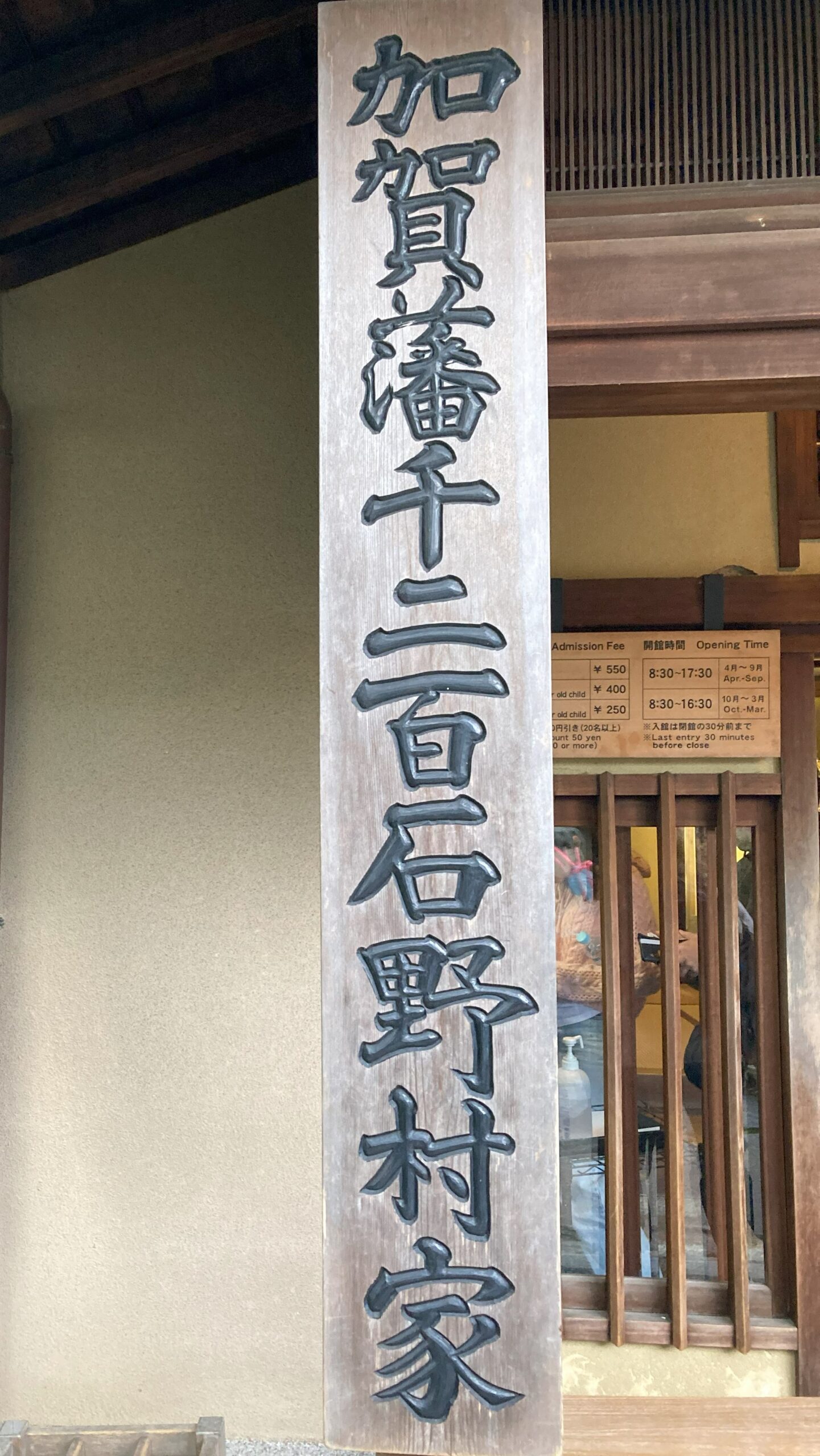
🔶今回も最後まで読んで頂き大変ありがとうございます。もし何かご意見やリクエストございましたらお気軽に『Help Desk』にてお声がけくださいませ。Gold🔶R50414.V.10b.10a.10b/+250527
